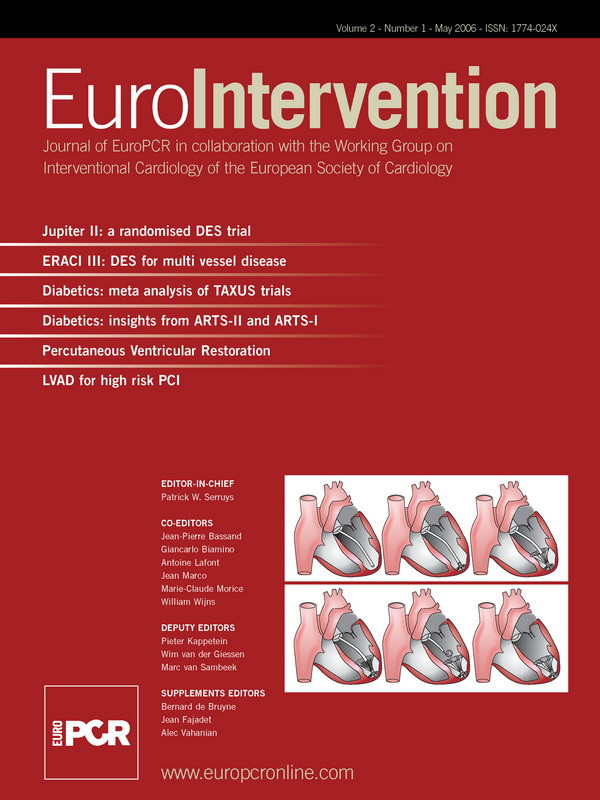Stents coated with agents that directly inhibit cell cycle progression and the migration of vascular smooth muscle cells eluted from polymer carriers (the so-called drug eluting stents: DES) prevent the development of neointimal proliferation and injury-induced arterial intimal thickening. In controlled randomised studies, DES demonstrated efficacy and safety, significantly decreasing in-stent restenosis and the subsequent need of target vessel revascularisation – without evidence of reductions in the rate of death or myocardial infarction (MI)1
In unselected patients treated in daily practice the mid-term need for clinically driven target vessel revascularisation is reduced by using DES, but the cumulative incidence of death and death or MI is similar between the groups of patients treated with DES or bare metal stents (BMS).2,3
Therefore, based on the evidence that we have today, the only promise of DES is the reduction of clinically driven target vessel revascularisation without reduction of cardiac mortality or MI.
Why do I feel the need to evoke the precautionary attitude with DES?
A precautionary attitude or ethic is a call to anticipate – and thus strive to understand and integrate the knowledge of risk – no matter how uncertain - into our daily practice.
“Precaution allows us to imagine all those incidences and events which cannot yet be proved, but which we, through our instinct, experience and emotions, sense could exist. We ask ourselves, no matter what we are doing, that we be prepared and able to predict an element or event that is not at all predictable, but which we cannot rule out as being impossible.” (translated from remarks by Hubert Curien).4
The potential risk of DES is late acute stent thrombosis (LAST)5.
Based on the design of the pivotal clinical trials that led to the approval of DES, dual antiplatelet therapy is prescribed on an empirical basis for 2 months after implantation of sirolimus-eluting stents, and for 6 months after implantation of paclitaxel-eluting stents, with life-long aspirin use6-8. The randomised trials conducted to assess the efficacy and safety of DES were not adequately powered to detect or exclude the effect of DES on rare events such as LAST, especially after discontinuation of dual antiplatelet therapy1,8.
DES is effective only when the drug is eluted from the polymer carrier1,9. In sensitive patients, non-biodegradable polymers may promote a hypersensitive reaction, or endothelial dysfunction localised in the stented arterial segment when the drug is completely eluted off the stent, this can lead to late in-stent thrombosis5. There is also concern that DES might be susceptible to late thrombosis when antiplatelet therapy is discontinued and endothelialisation of the stent struts is delayed10.
The incidence of LAST after DES implantation is probably low (0.35 to 2.6%)11-13, and may be underestimated, but is potentially problematic given the rapid rise in the widespread use of DES in high-risk patients with complex lesions (in 2006, 500,000 patients in Europe) and the risk resulting from stent thrombosis14. This LAST occurs most often after stopping the association of aspirin-clopidogrel, but also when clopidogrel is stopped alone and aspirin is continued, or in patients who are stable under aspirin10-12. Stopping the association of aspirin and clopidogrel becomes an important factor in predicting LAST (Hazard Ratio: 95%; confidence interval: 15 - 220, rarely seen in cardiology!)11.
This forms the basis for our doubt and questioning, leading us to adopt an Attitude of Precaution. The potential problems faced when stopping dual antiplatelet therapy after DES implantation (for non-cardiac intervention, or any other reason including non-adherence to the treatment15) should be taken into consideration before proposing aggressive percutaneous coronary reconstruction with DES in patients with left main bifurcation stenosis or complex lesions requiring endoluminal reconstruction with multiple overlapping DES.
In the randomised studies, patients are selected and the treatment protocol is explained in detail. The investigating physicians are alerted to any modifications in the treatment or concurrent interventions that are required.
In daily practice the efforts for optimising adherence to treatment are often followed by mediocre results15.The decision to stop antiplatelet therapy, for whatever reason, must take these possible consequences and risks into account. We must remain conscious of the fact that the majority of the patients we treat are more than 60 years of age. This means that a certain number will need, within two years following implantation of DES, an operation, or suffer a bleeding event, which could pose the problematic of ending antiplatelet therapy.
The knowledge of the potential risk of LAST poses challenges to our ethical obligation to keep our patients clearly informed.
Our Precautionary Attitude should be considered as the point of compatibility between the exigencies of innovation and the control of risks –real or potential. Armed with this concept of Precautionary Attitude, the interventional cardiologist is legally bound to provide clear and precise information on the potential risk of LAST before the implantation of a DES.
Transparency is indispensable: the patient should have the freedom to choose whether or not they want to receive a DES or BMS.
We should consider this as one of the fundamental foundations in an Ethic of Precaution based on the principle of responsibility. Worried by an excess of “it’s possible to treat by DES versus available knowledge”, we must still strive to do our best, associating our practice with the moral imperative of the potential risks and incertitude involved. The Precautionary Attitude will incite us to not do anything that could compromise our mission: to increase longevity while improving the quality of life of our patients. Innovation is the path we choose in this mission, and to this end our Attitude of Precaution, transformed into a veritable Precautionary Ethic, should be considered as a positive step forward, stimulating new research oriented towards the controlled elution of antiproliferative drugs or new agents from improved polymer biocompatibility and non-polymeric drug carriers or reservoirs.
Ackowledgments
The assistance of Sally Vincent with this editorial was gratefully appreciated.

